Crocus varieties for planting in autumn
Crocus is also called "spring saffron", it is used to decorate flower beds in summer cottages in early spring. Often used to create green slides. The bulbous plant is not demanding to care for. In the fall, crocuses are planted in open ground, and leaving this until spring ends - the florist just needs to wait for shoots and the appearance of peduncles.
It is not possible to achieve flowering in early spring from all varieties. Early flowering varieties are:
- Spring crocus. Like other varieties, it is a herbaceous plant with a stem length of about 15 cm. The flower is funnel-shaped, painted purple or white, and the anther is yellow. An adult bulb is renewed annually, reproduces no more than 3 peduncles during the growing season. This species includes the following varieties: Nigro Boy, Pickwick, Remeberans, Stoustor.
- Golden-flowered. Plant length about 20 cm, yellow flower appears before narrow, bright green leaves. The bulb is pressed down, spherical in shape. The species includes the following varieties: Blue Pearl, Lady Keeler, Snowbunting, Blue Bonet.
- Crocus Geyfel. Plants are distinguished by the following varietal characteristics: a round bulb, linear leaves with curled edges, purple or white petals. These varieties are valued for their long (more than 25 days) flowering. The group includes: Oxonion, Bagila, Albus, Artabir.
- Thomasini. Varietal characteristics: a short plant up to 8 cm in height, narrow leaves, a large purple, white or lilac flower. It is an industrial grade and is of no value to collectors. Often used for landscaping city parks, flower beds. Varieties: Lilac Beauty, Rossi, Purple Giant.
Interesting to know! Crocus or netted saffron is an incredibly beautiful variety, characterized by longitudinal stripes on the petals of flowers, but it is impossible to grow it on a personal plot. A rare species listed in the Red Book. In natural conditions, it is found in Russia, namely in the Crimea and Transcaucasia.
These crocuses can be planted in autumn, in contrast to late-flowering varieties. Despite the fact that the plant is not very demanding, for good flowering it is necessary to provide it with good conditions and proper planting.
Crocuses - planting and care
Spring flower crocus, or saffron, as it is also called, belongs to the perennial iris family. It got its name for the bright yellow shade of floral stigmas. Even in ancient times, clothes were dyed with it, and medicines, incense and spices were made from crocuses. Crocus flowers come in a wide variety of colors, from light monochromatic to two-color. Many gardeners who would like to breed a crocus on their plot are interested in the peculiarities of the care and planting of this flower.
Crocus care and cultivation
Experience shows that it is not difficult to grow crocuses in the garden and take care of them. These plants love open and well-warmed places by the sun. A short flower without a stem has dark green leaves extending directly from the corm. Its goblet flowers open in sunny weather, and on cloudy or at night, on the contrary, they close.
Crocus blooms most often in the spring, although in autumn you can also see these graceful flowers in the garden. Depending on the flowering period, the planting time of crocuses is also distinguished. If you have a spring-flowering plant, then it should be planted in late summer - early autumn. If you are late with planting, then the flowering of the crocus will be weak, because it will have very little time for the formation of roots and the formation of a point of renewal. Autumn-flowering crocus species are planted in summer.In addition, there is no need to dig up the bulbs every year; it is enough to transplant crocuses every five years. It is better to buy crocuses after they have faded. And if you buy them with color, then they will hurt and in the next season they may not bloom at all.
How do crocuses breed?
These beautiful primroses reproduce by seeds, corms, and their babies. Every year, the mother corm dies off, leaving several new ones in its place. After the flowering has ended, the corms intended for reproduction are dug out, dried and stored at a temperature not exceeding 20 ° C.
Seeds are sown in the fall directly into the soil. If this is done in the spring, then the seeds of the crocuses are preliminarily stratified. With this method of reproduction, the flower blooms after three to four years.
Planting crocuses in spring and autumn
Regardless of whether you are planting crocuses in autumn or spring, the first step is to choose the right place for them. In the shade, they will not bloom, and the snow from sunny places will come down faster. Crocuses love light, fertilized and well-drained soil. For these purposes, expanded clay, gravel or coarse river sand are suitable. Before planting, rotted manure with lime, compost or peat should be introduced into the hole. Corms must first be pickled in a special bactericidal solution. They are planted to a depth of 8 cm, and children - no deeper than 5 cm. If the plants decorate the flower bed, then they should be planted tightly so that the flower bed looks more decorative. Crocus seeds are sown in ridges to a depth of about 1 cm.
After the appearance of the first leaves, the ground around the plants must be loosened. Crocuses love watering throughout the flowering period. Without it, the flowers of the plant will be small. However, it is not necessary to water them during the dormant period.
Crocus is a winter-hardy flower, however, in severe frosts, it is still better to cover it with spruce branches or peat. But the plant tolerates small spring and autumn frosts without prejudice to itself.
You can feed the crocus three times during the season. The first time is in early spring, before the plant begins to grow. The second time - during the formation of buds. And the third time - after flowering ends.
Plant crocuses in groups in a rock garden or on a lawn, in a rockery or in an outdoor lawn, and they will become a real decoration of your spring garden.
.
Reproduction of autumn crocuses
Autumn crocus species are easier to reproduce than spring ones: they form up to 7 daughter corms annually. Autumn crocuses form "nests" - a group of related bulbs, which, after the death of the old bulb and the formation of a new one, become independent plants. It is them that are best used to increase the collection of crocuses, because only this method preserves the varietal characteristics of plants. When digging and transplanting, daughter plants are simply separated and used as independent ones. Since they bloom for 3-4 years, usually already next year, most of the separated bulbs will delight with flowering.
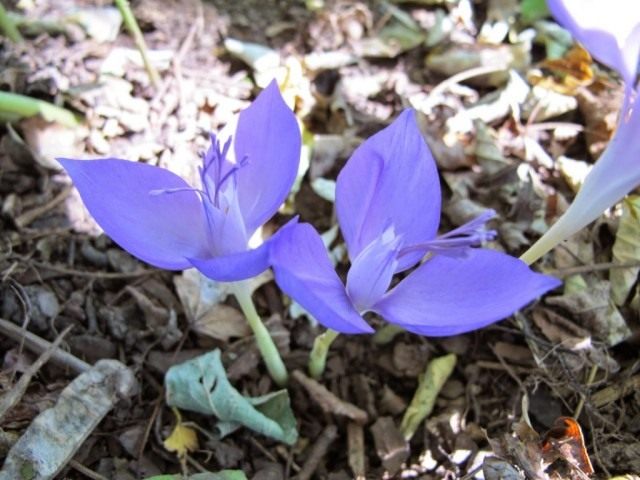 Banat saffron, or Banat crocus (Crocus banaticus). Jim murrain
Banat saffron, or Banat crocus (Crocus banaticus). Jim murrain
Crocuses can also be propagated by seeds, but this method does not allow preserving the characteristics of varietal crocuses, and the fruiting of autumn species is an irregular phenomenon and depends on the vagaries of the weather. Seeds of autumn crocuses are harvested in the spring, after natural stratification, sowing in the same year in summer or autumn. Sowing is best done in boxes or pots, covered with non-woven fabric or black foam. Plants from the first year are grown cyclically, but they bloom only 4-5 years after sowing.
General information about the crocus plant
The name of the plant comes from the Latin language. His second name is saffron. The garden crocus belongs to the genus Saffron, the Iridaceae family, the order Asparagales. The genus has more than 80 species.

Crocus is a perennial herb that blooms in spring or fall.
The onion of the plant is covered with scales, it is round or slightly flattened, up to 3 cm in diameter, with a fibrous root system. Basal leaves and, most often, a single flower develop from it (sometimes 2-3 flowers appear).
By color, crocuses are divided into yellow-flowered (shades from creamy white to bright orange) and blue-flowered (from pale blue to dark purple). Sometimes albinos and flowers with white veins are found.
In wildlife, saffron grows in alpine meadows, forests, steppes of Central and Asia Minor, South and Central Europe, North Africa, and the Middle East.
Additional Information! Dried flower stigmas are used as a spice of Asian, Mediterranean cuisine and as a natural yellow dye for homemade cheeses, butter, liqueurs.
Use in landscape design
Autumn crocuses are a real salvation for gardeners who dream of organizing an ever-flowering garden.
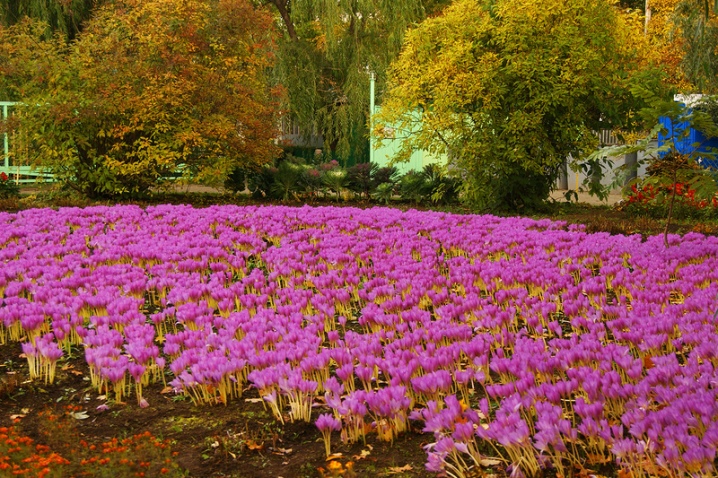
Due to the fact that autumn crocuses still belong to undersized garden crops, they are usually preferred to be planted on curbs, alpine slides or to create colorful volumetric patterns on flower beds with their help.

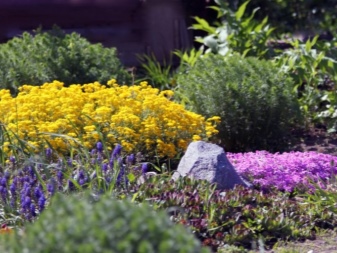
Autumn crocuses look especially attractive in autumn against the background of fallen tree leaves - that is why many people like to plant them separately from other garden plants. Some gardeners prefer to plant several different varieties of autumn saffron on the site at once to create a colorful and colorful flower bed. However, to achieve a beautiful result, you need to select varieties of these flowers with the same flowering periods.
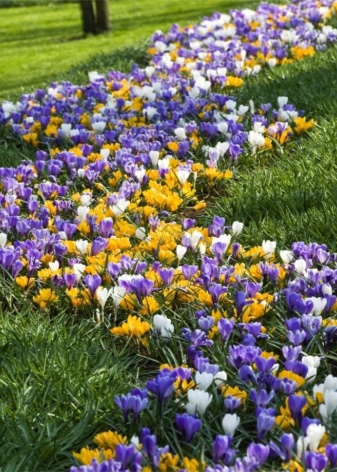

Since some fall crocus varieties can thrive in the shade, these plants can be planted near tall shrubs or conifers. Alternatively, crocuses can be planted along garden paths - these plants rarely grow wide and will not interfere with the passage through the site.

Planting and leaving autumn crocuses in the video.
Outdoor freesia care
From the moment of planting to digging the bulbs in the fall, flowers need watering, loosening the soil, removing weeds and complex fertilizing.
It would seem that such care is practically indistinguishable from caring for lilies, irises, gladioli. But growing freesia, like caring for it in the open field, is fraught with some difficulties.
The fact is that freesia blooms only at temperatures below +22 ºC. So that leaves and flowers do not suffer from a lack of moisture, the air must be constantly humid; it is extremely difficult for plants to tolerate sharp fluctuations in day and night temperatures. Because of these features, the flower is more often grown in greenhouses or under greenhouses.
In the open field, freesias are regularly irrigated with warm water in the evening, trying not to get on flowers and buds that have not yet opened. Watering begins immediately after germination and ends 2 weeks before the bulbs are dug.
For fertilizing flowers, you can use complex fertilizers for decorative flowering plants or, before flowering, add a mixture with a predominance of nitrogen, and use potassium-phosphorus agents closer to the middle of summer.
So that the bulbs can ripen better, and the plant blooms again, the wilted ones are cut off one by one or in groups. For bouquet cutting, inflorescences with two or more open corollas are suitable. Leaves damaged by fungi or pests can be shortened or removed. The bulbs are harvested in autumn, from September to October, before the arrival of night frosts.
Crocuses: growing and care
If you want crocuses to delight you with lush and beautiful flowers every season, you need to thoroughly prepare and learn about the features of care, reproduction and planting of these flowers. So that when growing outdoors you have fewer problems, you need to remember the following rules:
- Like many other ornamental plants, crocuses come in many varieties, each with a different bloom start time. Based on this, you need to know when to plant a particular variety. For example, if your chosen variety blooms in spring, then planting is necessary in the fall, and vice versa.
- Crocuses feel best in fertile and light soil, while they do not need frequent watering. If clay soil prevails in the place chosen for planting crocuses, it should be diluted by adding sand and fertilizers.
- In order for crocuses to grow well and start blooming on time, they must be provided with good lighting. It is enough to comply with this condition, and then you can be sure that every season the plant will delight you with large flowers. Of course, you can grow it in partially shaded conditions, but keep in mind that the flowers here will turn out to be not as bright and saturated than those for which the most comfortable conditions are created.
- While waiting for the moment to germinate, you must constantly keep the soil moist. When you notice the first shoots protruding from the ground, the plant needs to be well watered. In the future, this should not be done too often; as part of caring for crocuses, watering is carried out only if there are signs of drying out of the earthen coma.
- If you have chosen a plot with fertile soil for planting and are planting crocuses here for the first time, then you do not need to apply fertilizer for flowers this year. It is worth thinking about feeding if you have to grow crocuses on the same substrate for several years.
- It is necessary to apply fertilizers for flowers at least 3 times per season. The first feeding is carried out at the moment of emergence of sprouts, the second - in the phase of ovary formation, and the last - after the end of flowering. For crocuses, it is necessary to take fertilizers containing potassium and phosphorus. Potassium will give the plants the strength to grow and form bulbs, and due to the presence of a sufficient amount of phosphorus in the soil, the plants will be able to set buds in time and begin the flowering phase.
- When choosing a planting scheme, bulbs must be based on their size. If the bulbs are small, they must be buried in the ground no more than 5 cm, large ones are planted to a depth of 12 cm. Plants should be planted at an interval of at least 5 cm from each other. Sometimes this distance can be reduced to 3 cm, if you are not going to grow them in a new place.
Caring for crocuses after flowering is easy. If you are not going to transplant them to a new place this year, then all you need to do is remove the dead ground part after flowering. If your site is in harsh climatic conditions, then you will have to protect the crocuses from the winter cold. To do this, cover them with a leaf pillow or dry grass.
Leaving during flowering
It is helpful to remove weeds so that harmful grasses do not absorb nutrients from the soil.
Loosening is carried out carefully to enrich the soil with oxygen.
It is useful to feed crocuses with fertilizers based on potassium and phosphorus.
Moderate watering is important: the drying out of the soil during the flowering period negatively affects the plant.
It is important to remove faded buds in time.
Crocuses after flowering
Unfortunately, delicate buds do not decorate gardens and flower beds for a very long time: only two to three weeks, depending on the variety.
It is important to know what to do when the crocuses have faded. After yellowing and wilting of the leaves, the bulbs are dug up together with numerous children, the number of which often reaches 8-10 pieces. On a note! Most species of crocuses tolerate wintering well in the ground and there is no need to create shelters from fallen leaves, spruce branches or peat
If the winter is usually very cold and little snow in the region, then you can additionally cover the planted bulbs in the ground with the listed natural materials for reliable protection from frost.
On a note! Most crocus species tolerate wintering well in the ground and it is not necessary to create shelters from fallen leaves, spruce branches or peat. If the winter is usually very cold and little snow in the region, then you can additionally cover the planted bulbs in the ground with the listed natural materials for reliable protection from frost.
When and how to dig up the bulbs
Planting material for growing delicate and bright flowers is taken out of the soil at different times, taking into account the variety:
- spring-flowering varieties - from July to the end of September;
- autumn flowering varieties - from June to August.
It is important to act carefully so that the bulbs remain intact, otherwise the planting material will rot. For subsequent planting, only healthy, whole specimens are needed. It is useful to treat each instance with crushed coal: the risk of bulb rotting is significantly reduced
It is useful to process each specimen with crushed coal: the risk of bulb rotting is significantly reduced.
Storage of planting material
If the planting material is dug out without damaging the dense base, then the collected elements can be placed in a cool place. Before storage, damaged, dry roots are removed from the bulbs, rotted scales are removed, but the inside is not exposed.
Conditions for preserving planting material:
- dry, ventilated room;
- temperature - about + 8 ° С ... + 10 ° С degrees;
- without access to light.
Experienced flower growers advise a simple device for storing bulbs - a dense paper packaging from eggs. The meshes are large enough to fit a medium or larger base. In paper containers, the bulbs are well ventilated, you can easily increase the size of the gap for air in and not disturb the young base.
You can not keep sick, fungus-infected specimens for planting: rot often spreads to neighboring bulbs.
Forcing crocuses by a certain date
Forcing crocuses by March 8
Crocuses are easy to distill. It is worth planting several pots in October and exhibiting at a specific time, and you will get a flowering plant by the planned date, for example, March 8th.
Forcing time is 12 to 16 weeks.
Variety selection
In order for the plant to bloom by a certain date, you need to choose suitable varieties
Better if they are hybrid, large-flowered. Autumn varieties are difficult to bring to bloom for the New Year or Christmas. In spring, on the contrary, it is difficult to get flowers to dissolve by March 8 or May 1.
When choosing the size of the corms, the date of the expected flowering is taken into account. The earlier the planned distillation. The larger the planting material should be.
Preparing for landing
Crocus bulbs
To prepare the dug out bulbs, you need to take a number of measures:
- For distillation in January: the dug out bulbs in the summer must be kept for 7 days at a temperature of 34 degrees, then 14 days at 20 degrees. Then it decreases until mid-August to 17 degrees. Further, keep at +9 degrees until landing. It is held at the end of September.
- For forcing in the spring: after digging and until early August, the temperature should be 20 degrees, then it is reduced to 17. Planting is carried out in October or early November.
The purchased bulbs must be kept at room temperature for a week before planting, then folded into a paper bag and placed in the refrigerator door for several days.
Substrate
Any soil mixture is suitable for forcing
For flowering crocuses spend nutrients accumulated in the corms. It can be planted in sand, expanded clay, fine gravel and even in water. If you plan to reuse the bulbs, then you need to use purchased land for flowers.
Pot selection
The container for forcing crocuses at home should be wide and shallow.
There must be a drainage hole at the bottom. Containers or flower pots can be used. A container with a diameter of 15 cm can hold 10 corms.
Landing
You can plant different varieties of crocuses in one pot
Step-by-step planting process:
- Fill the pot with soil.
- Moisten, the soil should settle a little.
- Spread the bulbs on the surface. They need to be pressed a little into the substrate. They should be laid quite tightly, but not in contact with each other and the walls of the planting container.
- Cover with earth and water on top. It is not recommended to seal the top layer.
They must have the same growing season. This will ensure simultaneous flowering.
Cooling
Planted crocuses should be covered and placed in a cold place.
The temperature should be positive, but not exceed 9 degrees. A refrigerator or cellar is suitable for this. Cooling should be 3 to 4 months. This process stimulates rooting, which promotes the blossoming of flowers at the right time.
Bloom
Planted crocuses should be covered and placed in a cold place.
When it's time for the pots, get out and remove the lids. Crocuses need to be watered and placed in a cool room. After a few days, green leaves will begin to appear. Very soon they will bloom their flowers.
Crocus readiness criteria for flowering:
- The sprouts should grow at least 5 cm. This is the weakest of all.
- It should be tight to the touch. An empty sprout is not ready to release its leaves.
- The roots of the plant should emerge from the drainage hole at the bottom of the pot.
So, the criteria are met, it's time to exhibit flowers. You need to put them on the windowsill, ensuring the flow of light. The room temperature should not exceed +15 degrees.
Crocuses at elevated temperatures will immediately react and release leaves and bloom. They will bloom very quickly under very warm conditions. If it is very hot, the process may take only a few hours.
In order for the flowers to delight as long as possible, you need to create a temperature regime of 10 - 15 degrees. It will also prolong the exposition of the pots at night in a room with a temperature of at least 1 degree Celsius.
If you want to re-plant the corms, you need to leave them in the room. Watering occasionally until the leaves turn yellow. They keep until planting in the ground in the fall. They cannot be reused for distillation.
Diseases and pests
In central Russia, growing crocuses in the open field is a very pleasant thing, but this plant can be threatened by mice, moles, caterpillars of butterflies - scoops and slugs. Garden turntables help to get rid of rodents; unfortunately, you have to collect caterpillars and slugs by hand.
Crocus flowers growing and care is complicated by the presence of viral diseases: whitish spots appear on the buds, the tips of the petals are deformed, as a result, the flowers do not open. There is no cure for viral infections. the affected plants are destroyed, the soil is disinfected with a solution of potassium permanganate. Against fungal diseases (softening of corms, the appearance of spots under the scales), digging and drying of planting material, followed by processing with a solution of potassium permanganate or fudanzol, helps. Unfortunately, the affected specimens must be destroyed.
Yellowing of crocus leaves (chlorosis) can be caused by improper growing conditions (poor drainage).
Boarding and transfer rules
Crocuses do not need specific care, but the planting of such plants should be taken very responsibly. All planting procedures for autumn saffron can be roughly divided into 2 phases:
- choosing a suitable place;
- planting a flower.

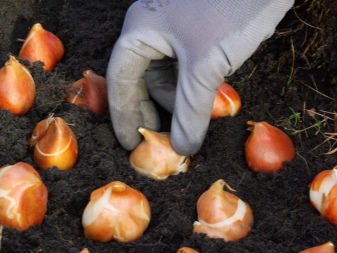
Seat selection
In many respects, the conditions for the planting site of autumn crocuses will coincide with the conditions for planting spring varieties, but there are also some peculiarities here.
- Most varieties of autumn-flowering crocuses adore sunlight, but if there is constant and hot sun on your site, then the plant should be planted in partial shade. Some crocus varieties, such as Sharoyan, need regular shade for abundant flowering, so it is better to plant them near large trees or shrubs.
- When looking for a place for autumn saffron, you should immediately abandon the windy areas with a lot of drafts and cold winds. It is best to choose a location where the plant is protected from the windy side by other crops, a fence or an extension.
- Avoid planting saffron in lowlands and places where moisture accumulates during spring floods. Bulbs of autumn crocuses are very susceptible to rotting, so it is wiser to plant this garden crop on small hills or form small raised earthen beds (for example, an alpine slide). A universal option would be to install high-quality drainage in the crocus hole.
- Autumn crocuses differ in individual preferences for the type of soil on the site for their planting. Best of all, they get along on light sandy loam or loam, which quickly absorb moisture. If you have a Dutch variety of autumn saffron at your disposal, then these flowers can grow on any type of soil. When the soil on the site is insufficiently nutritious, a few weeks before planting it should be fertilized with mineral or organic fertilizers (compost, ash or humus) and thoroughly dug up. If we talk about the type of soil in terms of the level of acidity and alkalis, then a neutral soil is best suited for saffron.
Landing in open ground
The process of planting autumn saffron is not much different from planting spring crocus varieties. The key points of planting these plants will be indicated below.
- 2 weeks before planting the crocus bulbs in the ground, be sure to feed the flower beds where the flowers will grow.
- The depth of the holes for autumn saffron is not so important, here it is the width that is much more important - over time, the plant acquires a large number of additional shoots and bulbs, which form a massive and dense ball.
- If you are going to actively propagate autumn saffron, then the bulbs should be placed in large polymer pots and put in the ground with them - this will help you safely dig up crocus bulbs in the future to grow new flowers. If saffron is planted in the area just to complement the landscape, then the bulbs are planted without pots.
- Unlike spring crocuses, autumn saffron should always be planted in groups of 5 or more bulbs. During planting, keep a distance of at least 5 cm between fruits. The planting depth should be chosen based on the size of the bulbs and tubers themselves - large bulbs are always planted deeper. Ideally, the planting depth of autumn saffron should be twice the size of the tuber itself. Also, the depth very much depends on the type of soil - for lighter soils, it should be greater (up to 9 cm).
- If we talk about the influence of the depth of planting on the development of the plant itself, then the number of bulbs obtained as a result depends on it. For example, when planting a tuber to a depth of 5 cm in one hole in the future, it will be possible to find up to 10 young tubers.
- To plant autumn saffron in open ground, the bulbs are placed by hand in the dug holes, then sprinkled with soil and lightly compacted. After planting, watering is required.
Transfer
These plants can be transplanted to another location during the spring or in the very first days of autumn (depending on the variety). Transplanting is usually carried out if your crocus bushes consist of many shoots, and there is an obvious overflow of the planting "nest".
To prepare the bulbs for planting, they should be thoroughly dried for 2-3 months in a warm and ventilated area.After drying, dry layers are removed from the bulbs, old roots and scales are removed.
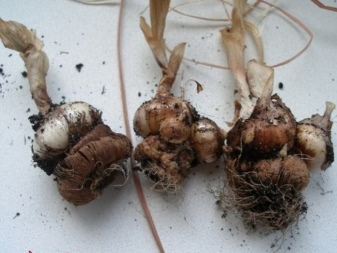
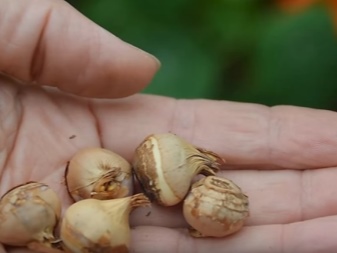
Before planting the bulbs, which is carried out in the same way as planting adult tubers, do not forget to check them for rot or empty bulbs. Experienced gardeners advise against transplanting autumn saffron more than once every 3-4 years.


